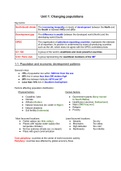Unit 1: Changing populations
Key terms:
North-South divide The increasing inequality on levels of development between the North and
the South or between HICs and LICs
Development gap The difference in wealth between the developed world (North) and the
developing world (South)
OPEC The organization of petroleum exporting countries: represents the interests
of oil exporters. Its position is undermined by some oil-producing countries
such as the UK, which does not agree with the OPEC-controlled prices
G7 / G8 A group of the world’s wealthiest and most powerful countries
G10 / Paris club A group representing the wealthiest members of the IMF
1.1: Population and economic development patterns
General notes:
● 75% of population live within 1000 km from the sea
● 85% live in areas less than 500 meters high
● 85% live between latitudes 68°N and 20°
● Less than 10% live in Southern hemisphere
Factors affecting population distribution:
Physical factors: Human factors:
● Coastline / jobs ● Government grants (Sony moved
● Climate to South Wales)
● Altitude (Andes) ● Healthcare (vaccines, Switzerland)
● Natural resources (ex: water in Niger) ● Wars (2003 Iraq war)
● Natural disasters ● Religion
● Soil fertility (Indonesia) ● Poverty
Most favoured locations: Least favoured locations:
● Fertile valleys (ex: Nile valley) ● Deserts: Too dry
● Places with regular water supply (like ● Mountains: Too steep
temperate climates) ● High latitudes: Too cold
● Not too extreme climate (ex: no desert) ● Rainforests: Too infertile
● Place with good communication
Core periphery: countries at the center of world economic activity
Periphery: countries less affected by global economy flows
,Classifying countries:
Low-income country (LIC) Less economically developed $0 - $1.025
Middle-income country (MIC) ⅓ of Global GDP. Divided into lower $1.025 - $12.735
middle-income countries (1k-4k) and
higher middle-income countries (4k-12k)
High-income country (HIC) Developed, advanced $12.735 - ….
More economically developed Most developed countries with highest
countries (MEDC) standards of living (UK and US)
Newly-industrializing Rapid industrial, social, and economic
countries (NIC) growth since 1960
Recently industrialised
countries (RIC)
● BRIC: Brazil, Russia, India, China
● MINT: Mexico, Indonesia, Nigeria, Turkey
● CIVETS: Colombia, Indonesia, Vietnam, Egypt, Turkey, South Africa
● Next Eleven: Bangladesh, Egypt, Indonesia, Iran, Mexico, Nigeria, Pakistan,
Philippines, Turkey, South Korea, Vietnam
● Asian Tigers: Hong Kong, Singapore, South Korea, Taiwan
Lots of LICs are become MICs (example: India, Kenya)
Analyze Indicators of development:
● Qualitative: Attempts to describe a country's development in terms of those factors
which influence people's quality of life
● Quantitative: Use statistics to measure certain aspects of a country
● Composite: Combine several other measures into a single figure
Human development index (HDI): Measures life expectancy at birth, years of schooling, GNI
Multidimensional Poverty Index (MPI): Nutrition, schooling years, sanitation, assets, …
Forced migration When a person has to move because of violence, danger, fear of
persecution, orders by a government or authority. Or due to
environmental reasons such as natural disasters or famine.
Economic migration The choice to move to another place in search of a better standard
of living and a regular wage
Voluntary migration A person moves from one place to another by their own free will
Millionaire city A city with 1+ million residents/inhabitants
Megacity City with 10+ million inhabitants
, CS: China
China is sparsely populated in West (periphery) and densely populated in East (core)
Cause:
● Physical geography:
○ Only small proportion of areas provides rain-fed agriculture
○ Much land is too dry or too steep (ex: himalaya)
● Coastal and river locations preferred for trade & commerce (ocean)
Consequence: High rate of urbanization
● Huge internal migration: 38 million between 2000 and 2005
● 11% of population lives on 0.5% of land
Push factors: Pull factors:
● Poverty ● Job opportunities (40% higher wages)
● Poor sanitation ● Safety
● Low job security ● Better lifestyle
● Political instability ● Education
CS: South Africa
Densely populated in North-east and coastal cities with up to 1000 people/km2, while sparsely
populated in west and Northern cape (>5 people/km2)
→ General decrease from south-east to north-west
● Availability of mineral resources, trade (coastal cities), and farming potential
● Pattern follows rainfall intensity pattern: lowest densities in arid areas and mountains
3 main periods of internal migration during the 20th and 21st centuries:
● Economic migration linked with industrial development until 1950
● Forced migration related to the apartheid movement
● Voluntary migration following the collapse of the apartheid system
→ Circular migration: worker repeatedly moves between home and host area
Push factors: Pull factors:
● Poverty/corruption ● Lack of safety ● Security ● Education
● Unemployment ● Natural disasters ● Job opportunity ● Quality of life
● Desertification ● High crime rate ● Sanitation ● Trade
● Lack of sanitation ● Family ● Agriculture
1.2: Changing populations and places
Population change:
● Natural increase: 𝐶𝑟𝑢𝑑𝑒 𝑏𝑖𝑟𝑡ℎ 𝑟𝑎𝑡𝑒 − 𝐶𝑟𝑢𝑑𝑒 𝑑𝑒𝑎𝑡ℎ 𝑟𝑎𝑡𝑒
● Net migration: 𝐼𝑚𝑖𝑔𝑟𝑎𝑡𝑖𝑜𝑛 − 𝐸𝑚𝑖𝑔𝑟𝑎𝑡𝑖𝑜𝑛
, Terminology:
Life expectancy Average number of years a person is expected to live at birth
● Lower in poor countries
● Men have lower than women because of physical labour,
unhealthy lifestyle, x-linked diseases, and conflict
Infant mortality rate (IMR) Number of deaths of children >1 y/o per 1000 live births a year
Child mortality rate (CMR) Number of deaths of children 5 y/o per 1000 live births a year
Crude birth rate (BR) Number of live births per 1000 of the population per year
Total fertility rate Average number of children that are born alive per 1000 women in
childbearing age
Crude death rate (DR) Number of people who die per 1000 of the population per year
Natural increase Birth rate is higher than the death rate → increase in total population
Doubling time # of years needed for population to double in size:
70
𝑁𝑎𝑡𝑢𝑟𝑎𝑙 𝑖𝑛𝑐𝑟𝑒𝑎𝑠𝑒 (%)
Demographic transition model (DTM): Explanations page 397




